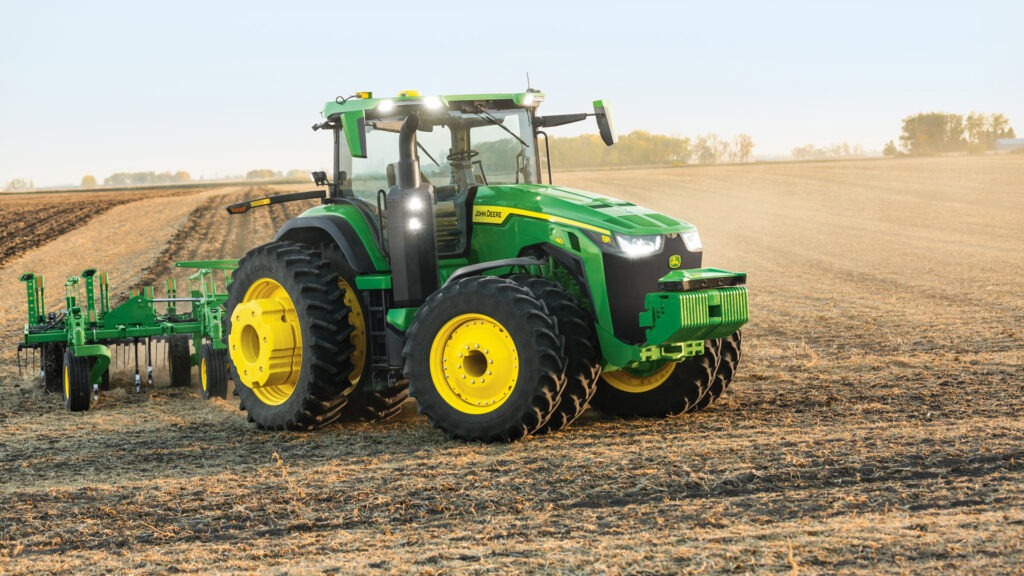Think about your last meal, your toothpaste, your T-shirt. Do you know where they came from? There are many steps that go into the food on your plate, the products in your bathroom cabinet, and the clothing in your closet. They might seem disconnected, but their origin is the same: a farm.
Farming is the root of global food production and household products — and has been for centuries. Most of these products are made from the byproducts of grains like soybeans, corn, wheat, and cotton, which come from large-scale agricultural production. Multiple steps make this possible, including tillage, planting, spraying, and harvesting.
The Farmers’ Experience
Tillage is the process of preparing land for the growing of a crop. Farmers attach a plow — picture a metal rake and multiply its size by 20 — to the back of their tractor. Turning the soil at just the right time prepares it to accept the seed and increases the chances of growth. Tillage is the first step in the agricultural process, and its completion determines the timeline for the rest of the growing season.
After tillage comes the planting of the seed, which is done by high-tech machines that meticulously drop thousands of individual seeds into the ground at record speeds. The timing of planting is the most critical element of the system — even being one week off can lead to reduced yields later in the year. Once the seed turns into a delicate plant, the farmer must defend the precious upstart from natural enemies like weeds, who are looking to steal valuable nutrients from the plant. This leads to the next important step of caring for the plant by delicately and precisely applying herbicides and pesticides.
Last, but far from least, is harvest. During harvest time, a machine called a combine – really a factory on wheels – collects the grown crop. The front of the combine cuts the wheat and corn plants at ground level and the main body of the machine processes the grains by removing the stem and leaves. Farmers typically have a very short window of time to harvest crops. It is at this critical moment that farmers find out if they made the right tilling, planting, and spraying decisions throughout the season.
Then, the process starts all over, with the best farmers incorporating ‘lessons learned’ from the recent season into the next year. Farming is a year-round job with limited windows of time to complete each step. Farmers need to continually monitor weather conditions, track machine health, and monitor crop yields, all while developing plans and timelines for the year to come.
The Challenges Facing Today’s Farmers
Clearly, this is all a lot of work — and it’s only going to ramp up. The world is growing rapidly, and by 2050, the global population is expected to reach 10 billion people. To feed this number, farmers need to produce twice the amount of food they’re churning out today. The answer seems simple: just hire more help. Unfortunately, there isn’t enough. Today, less than 2% of the U.S. population is actively involved in agriculture. The rate of growth is less than any other job in the country. It’s also not a matter of “working harder” — farmers are on the job almost 24×7. The average farmer is 55 and already putting in 18 hours a day. Ultimately, farmers need to increase productivity across all steps of the farming lifecycle and do so with limited labor. The only way farmers can realistically meet this goal is by using advanced technologies.
Technology’s Role in Precision Agriculture
To support the needs of farmers, technology, and mechanization have become increasingly integrated into agriculture. Today, one of the most promising influencers on the farm is a technology-driven concept called precision agriculture. Precision agriculture — or the ability to focus on the success of each individual plant — requires an integrated crop management system. Individually focusing on each plant makes it more likely for the entire crop to produce a bountiful harvest. When trying to meet the needs of the growing world population, no food can go to waste.
Advanced technologies make precision agricultural practices possible. For instance, when artificial intelligence, machine learning, and robotics integrate into traditional agricultural machines — like a sprayer — it’s possible for farmers to easily locate, assess, and treat each plant. The traditional process is to spray every acre, every field. Of course, killing the weeds that take up valuable nutritional resources from crops is important. However, there’s a problem associated with this: traditional spraying doesn’t just spray the weeds; it also sprays the ground and even the crop itself. But, when a smart sprayer is equipped with machine learning and computer vision, it can differentiate weeds from crops, detecting weeds as small as the camera lens on your iPhone. This exponentially reduces herbicide usage, ultimately leading to lower costs and less stress on the environment.
Farmers’ Self-Driving Robotic Tool
Technology is taking the power of agricultural machines one step further into autonomy. Often trained with hundreds and thousands of images, autonomous machines use computer vision and machine learning to monitor their surroundings and stop when an obstacle is in their way. And, unlike cars on today’s roads, autonomy is a reality on farms.
The most popular autonomous machines used by farmers are tractors, specifically for tillage. With autonomous tractors, farmers aren’t inhibited by working hours or daylight since they don’t need to be in the tractor to operate it. Therefore, the tillage process can happen when soil conditions are exactly right and without any extra hands. Autonomy also frees up farmers to manage other important, time-consuming tasks like analyzing crop yield and machine data. With connectivity, machines can automatically upload their progress on the field to the cloud. This lets farmers analyze data from the current growing season — and past seasons — on their phones to determine if they can make adjustments that allow them to produce even higher yields in the future.
The Future of the Farm
Agriculture is embracing advanced technologies, and as the world population grows, so will the industry’s reliance on technological innovation. Bringing precise, autonomous solutions to farmers reduces the stress of producing enough food with minimal labor, ensuring a seamless process of “farm to fork” for all of us.



